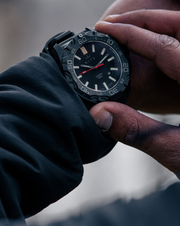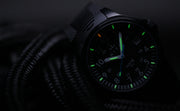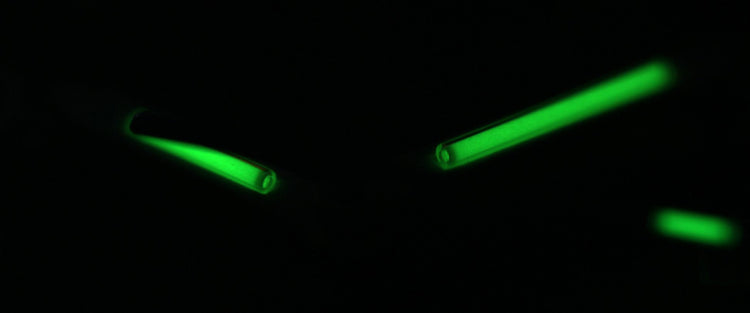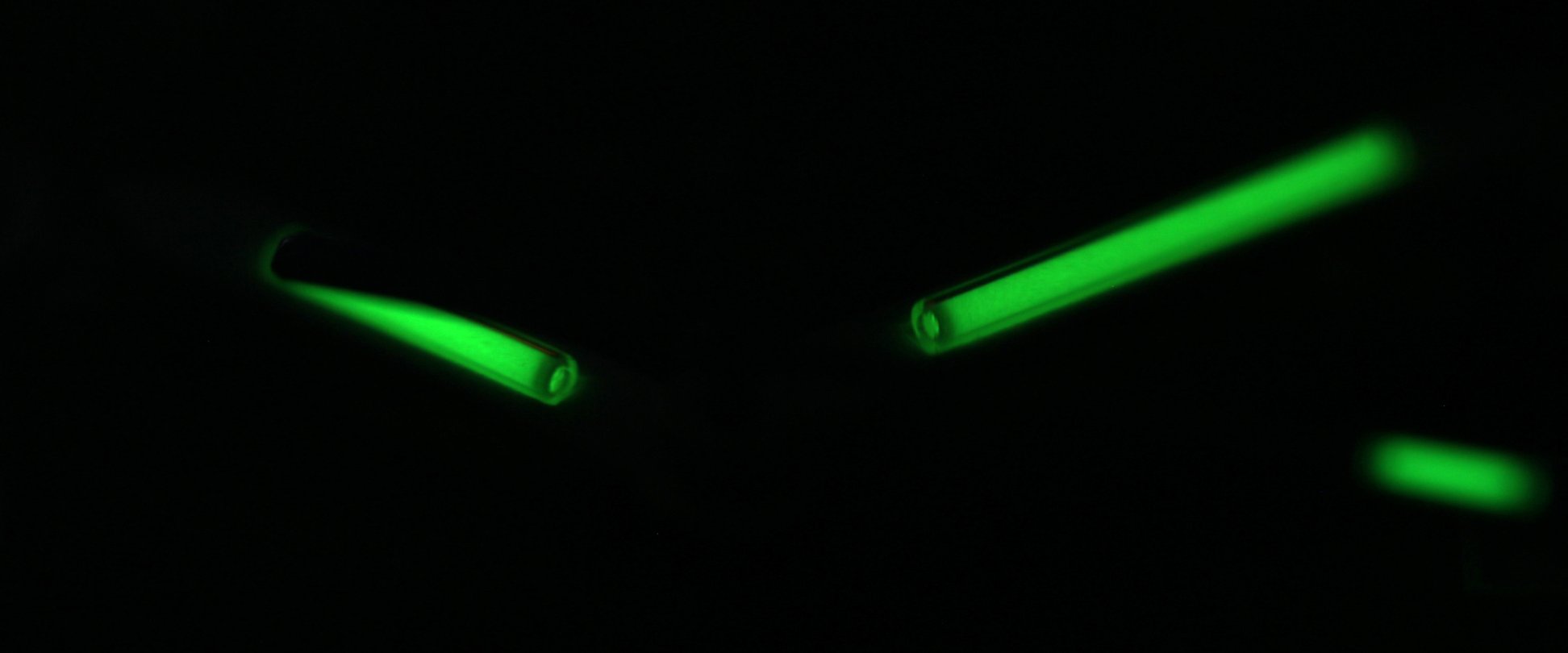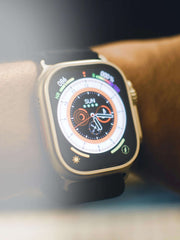Key Takeaways
- Tritium creates constant glow for decades without charging or batteries
- Swiss-made GTLS tubes are sealed glass capsules containing tritium gas and phosphor
- T25 and T100 ratings indicate brightness levels, T25 for tactical use, T100 for maximum visibility
- Tritium is significantly safer than old radium paint, with particles that can't penetrate skin
- Unlike SuperLumiNova, tritium maintains consistent brightness throughout the night without fading
- Premium brands like Ball, Luminox, and NITE build their reputations on tritium watch illumination technology
- Tritium tubes come in multiple colours with green being the brightest for glow in the dark watches
- Military forces worldwide trust tritium watches for night operations and tactical missions
- Swiss company MB-Microtec is the sole global manufacturer of precision tritium tubes
- Tritium technology costs more initially but provides decades of reliable performance in luminous watches
Understanding Tritium: Mission-Critical Illumination
When you're selecting equipment that must perform in complete darkness, tritium illumination isn't simply another feature, it's proven technology that's kept military professionals and serious operators on mission for decades. If you've ever found yourself unable to read critical timing information when visibility drops to zero, you understand why this technology matters for self-luminous watches.
Tritium represents a specialised form of hydrogen that's naturally radioactive in the most controlled way possible for horological applications. These radioactive watches use tritium to create glow in the dark watches that outperform traditional luminous watches in every operational scenario. Whilst ordinary hydrogen remains the lightest element, tritium contains additional nuclear particles that create instability, which becomes our advantage for continuous illumination.
What we've found works best is when these particles hit special phosphorescent material inside sealed glass tubes, creating that distinctive glow you see on premium timepieces without requiring external power sources or charging protocols.
Swiss manufacturers have refined this nuclear engineering process to create watch illumination sources smaller than standard components yet capable of providing reliable visibility for decades under operational conditions. The technology represents precision engineering meeting practical field requirements for professional luminous watches.
GTLS Technology: Precision Engineering Standards
GTLS technology, Gaseous Tritium Light Sources, represents sophisticated miniature engineering applied to watchmaking demands. These microscopic glass tubes, some measuring less than 0.3mm in diameter, contain pressurised tritium gas alongside carefully selected phosphorescent compounds.
The manufacturing process demands extraordinary precision tolerances. Glass capillaries receive internal coatings of specific phosphor materials that determine colour output characteristics. Following coating application, tubes undergo controlled tritium gas pressurisation before laser sealing to exact dimensional specifications.
Here's what makes this technology genuinely useful: unlike traditional luminous paint that needs daylight charging and fades overnight, tritium tubes provide steady illumination regardless of what's happening around them. The brightness stays virtually constant for years.
Each production tube undergoes comprehensive testing protocols covering brightness specifications, temperature resistance ranges, and containment integrity. The hermetically sealed construction eliminates performance degradation from moisture infiltration, temperature cycling, or mechanical shock that compromises alternative illumination systems. When military procurement specifies tritium watches, they're selecting technology proven reliable under extreme operational conditions where traditional glow in the dark watches would fail.
The MX10: Operational Heritage
The MX10 field watch demonstrates tritium technology under the most demanding operational conditions. Originally selected by UK Special Forces as standard issue equipment, this timepiece earned its credibility through field testing where equipment failure compromises mission success.
Constructed with T25 tritium illumination, the MX10 delivers controlled brightness optimal for tactical situations requiring reliable visibility without position compromise. The watch employs strategically positioned tubes ensuring maximum readability whilst maintaining the robust construction demanded by military applications.
The 39mm case houses Swiss quartz movement alongside tritium tubes validated through operational deployment across extreme environments, from Arctic conditions to desert operations. This represents equipment tested by professionals whose lives depend on gear reliability when conventional systems fail.
The MX10's credentials derive from operational reality rather than marketing narratives. When you examine the precision tube placement and case construction details, you recognise why Special Forces selected this watch as standard issue equipment. Performance under pressure defines operational capability.
Tritium Rating Classifications: T25 vs T100
You need to understand these ratings when choosing the right kit for your needs. T25 and T100 designations specify maximum tritium content per timepiece, measured in millicuries, directly correlating to brightness output capabilities.
T25 watches contain up to 25 millicuries of tritium, providing controlled illumination ideal for situations demanding discretion alongside visibility. This brightness level ensures clear time reading under complete darkness whilst maintaining tactical advantage through reduced signature. Military field watches commonly employ T25 ratings because they balance visibility requirements with operational security.
T100 timepieces accommodate up to 100 millicuries, delivering maximum brightness for applications where visibility takes priority over discretion. These watches produce significantly enhanced glow intensity, immediately visible at greater distances, making them suitable for emergency response, professional diving, or safety-critical applications requiring rapid time reading.
Operationally, the distinction becomes clear: T25 provides reliable time reading in darkness, whilst T100 offers noticeably brighter, more obvious illumination standing out under challenging conditions. Both ratings maintain brightness consistency over years of service, though T100 watches naturally exhibit superior luminosity throughout operational life.
For most applications, either rating performs effectively. However, when dealing with professional scenarios where maximum visibility ensures safety margins, understanding these specifications helps select equipment matching actual operational needs rather than aesthetic preferences. These luminous watches provide consistent performance across both rating categories.
T25 vs T100 Tritium: What's the Difference?
| Feature | T25 Tritium | T100 Tritium |
|---|---|---|
| Brightness | Good visibility in darkness | Very bright, obvious glow |
| Best For | Everyday use, outdoor activities | Professional diving, emergency work |
| Night Reading | Clear time reading | Easy to spot from across the room |
| Who Uses It | Military, hikers, outdoor enthusiasts | Divers, paramedics, rescue teams |
| Stealth Factor | Low-profile glow | Bright, noticeable light |
| Price | More affordable | Higher cost |
| Battery Needed | None - self-powered | None - self-powered |
| How Long It Lasts | 10-25 years of glow | 10-25 years of glow |
| Safety | Completely safe | Completely safe |
| Typical Watch Types | Field watches, everyday wear | Dive watches, professional tools |
Both types glow constantly without charging, unlike regular glow-in-the-dark watches that need light to charge up and fade after a few hours.
The Hawk: Professional Diving Standards
The Hawk tactical watch represents tritium technology optimised for professional operations, combining T100 illumination with 200m water resistance in purpose-built construction. This military-grade timepiece demonstrates how tritium excels in environments where traditional illumination systems prove inadequate.
Equipped with high-brightness T100 tritium tubes, the Hawk provides maximum visibility during extended underwater operations. The reinforced polycarbonate case and Swiss quartz movement ensure reliable performance whilst tritium illumination maintains consistent brightness regardless of dive depth or duration constraints.
What makes the Hawk particularly effective for professional applications is its practical approach to illumination placement. The tritium tubes are positioned to provide optimal readability of critical timing information, elapsed time, current time, and operational markers, without creating excessive brightness that might compromise tactical operations or night vision.
The watch's robust construction reflects the demanding requirements of professional operations, where equipment must perform flawlessly under pressure whilst providing essential timing information for mission-critical applications. This represents equipment that performs without compromise when conditions become challenging.
Tritium Safety: Technical Reality
Misconceptions about tritium watch safety require technical clarification. Tritium represents one of the safest controlled radioactive materials available, particularly compared to radium compounds used in historical timepieces that caused documented health problems.
Tritium emits beta particles characterised by extremely low energy levels. These particles travel approximately 6mm in air and cannot penetrate human skin layers, much less watch crystals or case materials. Even hypothetical tritium tube rupture inside a watch would result in harmless gas dispersion within minutes.
Watch-grade tritium operates under strict regulatory frameworks. UK and European markets mandate comprehensive safety standards specifying maximum allowable quantities and containment protocols. Sealed glass tubes used in quality watches undergo design validation for safe tritium containment throughout decades of normal usage.
Professional radiation testing confirms that tritium watch wear results in exposure levels significantly below natural background radiation encountered daily from cosmic sources and environmental elements. This safety profile explains why military forces, emergency services, and professional organisations worldwide specify tritium watches for mission-critical applications where reliability cannot be compromised.
Tritium vs SuperLumiNova: Performance Analysis
Choosing between tritium and traditional phosphorescent materials requires understanding fundamentally different performance characteristics. Each technology serves specific applications, though tritium offers distinct advantages for professional use cases.
Here's the reality: SuperLumiNova exhibits superior initial brightness following light exposure, creating impressive glow that can exceed tritium intensity during the first minutes of darkness. However, this brightness degrades rapidly. Within one hour, SuperLumiNova watches become difficult to read; after eight hours, they require external illumination for visibility.
Tritium maintains consistent brightness throughout extended darkness periods. Though initial output may appear slightly dimmer than freshly charged SuperLumiNova, tritium provides reliable visibility from darkness onset until dawn. This consistent performance proves critical for night operations, emergency response, or extended field activities.
Practically, professional watches using SuperLumiNova require pre-operation light exposure and may become unreadable during extended missions. Tritium tactical watches provide consistent illumination regardless of preparation protocols or operational duration, making them superior glow in the dark watches for professional use.
For professionals depending on timepieces during extended operations, tritium's reliable performance outweighs SuperLumiNova's initial brightness advantage. Consistency under pressure defines operational capability in professional luminous watches.
Tritium Colour Specifications
Tritium tubes offer multiple colour options, each providing different brightness characteristics based on phosphorescent compound selection. Understanding these variations helps match illumination to functional requirements and aesthetic preferences.
Green tritium delivers maximum brightness output, serving as the baseline for colour comparison in glow in the dark watches. Human visual systems perceive green wavelengths most efficiently, making this optimal for maximum darkness visibility. Military watches and professional timepieces predominantly use green tritium because performance takes priority over aesthetics.
Yellow tritium provides approximately 89% of green brightness whilst offering distinctive warm appearance. White tritium varies between 60-95% brightness depending on phosphor formulation, delivering clean, neutral illumination complementing traditional dial designs.
Ice blue tritium produces around 40% of green brightness but creates striking visual appeal, particularly popular in diving applications where colour evokes underwater environments. Orange tritium offers roughly 50% brightness, sometimes selected for applications where reduced intensity provides tactical advantage.
Colour selection typically depends on operational requirements versus personal preference. Professional users prioritise brightness efficiency, whilst enthusiasts may select colours enhancing overall timepiece aesthetics. Quality manufacturers offer multiple colour combinations, enabling personalisation without compromising core performance capabilities.
The Alpha: Traditional Design, Modern Performance
The Alpha series demonstrates tritium technology integrated into traditional diving watch architecture. Combining 300m water resistance with precision tritium tube placement, the Alpha delivers professional diving capability within classic design parameters.
What distinguishes the Alpha is its thoughtful integration of tritium illumination into a conventional diving watch layout. The tubes are positioned to enhance rather than overwhelm the dial, providing essential visibility whilst maintaining the clean, functional appearance that working divers require.
The 300m water resistance specification reflects serious diving capability, whilst tritium illumination ensures consistent readability throughout extended underwater operations. Unlike illumination methods requiring charging or exhibiting fade characteristics, the Alpha's tritium tubes maintain brightness consistency regardless of dive duration or environmental conditions.
For diving professionals and enthusiasts requiring reliable underwater timekeeping, the Alpha demonstrates tritium technology enhancing traditional dive watch functionality without compromising classic aesthetics that make diving watches appealing to both working professionals and collectors.
Swiss Manufacturing: MB-Microtec Standards
MB-Microtec AG maintains exclusive global capability for precision tritium tube manufacturing serving horological applications. Based in Switzerland, this company pioneered GTLS technology and continues advancing self-illuminating timepiece component development.
As inventor and market leader of tritium tube technology, MB-Microtec supplies virtually every watch manufacturer utilising this illumination method. Their manufacturing facilities represent precision engineering excellence, creating hermetically sealed illumination sources smaller than conventional mechanical components yet delivering decades of reliable performance.
Quality control protocols ensure each tube meets stringent specifications covering brightness output, temperature resistance ranges, thermal shock tolerance, and tritium containment integrity. This manufacturing precision explains why Swiss-made tritium tubes command premium pricing and why serious watch manufacturers specify MB-Microtec components exclusively.
Recent technological advances include enhanced brightness coatings and improved manufacturing techniques increasing light output whilst maintaining sealed integrity essential for long-term performance reliability. These innovations enable more sophisticated illumination patterns without compromising operational dependability.
The Atlas: Mechanical Excellence with Modern Illumination
The Alpha Z dive watch represents the next evolution in professional diving timepieces. Combining proven Alpha series reliability with enhanced specifications for demanding underwater operations, the Alpha Z features a 42mm case, Swiss Ronda 715 quartz movement, ceramic bezel insert, and 300m water resistance.
This timepiece demonstrates tritium capability enhancing rather than dominating watch design. The automatic movement provides mechanical satisfaction appreciated by enthusiasts, whilst tritium tubes ensure practical functionality during low-light conditions. This combination appeals to collectors valuing both horological tradition and operational capability.
The Atlas showcases tritium versatility beyond tactical applications. Here, illumination serves daily practicality, early morning activities, evening operations, or time checking without disturbing others in darkness. The Swiss movement ensures accuracy and reliability matching tritium illumination system longevity.
For diving professionals who appreciate advanced specifications whilst requiring reliable low-light visibility, the Alpha Z offers a compelling combination of evolved engineering and proven illumination technology. Advanced design and innovation complement effectively when executed with precision in these self-luminous watches.
Long-term Performance Expectations
Understanding tritium performance characteristics helps evaluate long-term value propositions. Unlike traditional luminous materials exhibiting rapid degradation, tritium offers predictable performance spanning decades.
During initial 10-15 years, tritium maintains excellent brightness with minimal output reduction. Manufacturers typically guarantee illumination performance for 10-25 years, though many tubes exceed specifications. Even as brightness gradually decreases over extended periods, quality tritium tubes continue providing adequate illumination for most applications well beyond guaranteed timeframes.
This longevity represents significant value compared to alternative illumination technologies. SuperLumiNova requires daily charging and fades within hours, whilst tritium provides consistent performance regardless of external conditions. For professional users, this reliability justifies premium tritium timepiece costs over traditional luminous watches.
From collector perspectives, tritium watches offer unique advantages. Limited production quantities, regulatory restrictions, and concentrated manufacturing expertise make authentic tritium timepieces increasingly collectible as technological artifacts representing significant practical horological advancement.
Selection Guide: Choosing Tritium Equipment
Selecting tritium watches requires understanding how specifications match intended applications. The decision involves balancing functionality, aesthetics, and budget considerations whilst ensuring chosen timepieces deliver genuine performance benefits.
Begin by identifying primary use cases. For general wear with occasional low-light reading, T25 watches provide adequate brightness whilst maintaining reasonable costs. Professional applications requiring maximum visibility benefit from T100 specifications, though these command premium pricing due to higher tritium content.
Our range demonstrates tritium technology versatility across different applications. The MX10 field watch delivers military heritage with proven T25 illumination, ideal for outdoor enthusiasts appreciating authentic tactical credentials. The Hawk series offers T100 brightness for professional tactical and emergency response applications where maximum visibility ensures safety margins.
For those seeking mechanical sophistication, the Atlas automatic combines Swiss movement precision with tritium illumination, proving traditional watchmaking and modern technology complement effectively. The Alpha series provides professional diving capability in classic styling, appealing to working divers and collectors alike.
Budget considerations should emphasise long-term value over initial cost. Quality tritium watches provide decades of reliable performance, making per-year costs competitive with premium watches requiring regular maintenance or electronic systems needing battery replacement.
What you need to consider is overall construction quality. Tritium illumination deserves timepieces built to matching standards, sapphire crystals, robust cases, and proven movements ensure investments deliver consistent performance throughout tritium operational life.
Future Technology Development
Tritium technology continues advancing, with manufacturers developing innovations enhancing brightness, longevity, and application versatility. Recent developments suggest tritium's role in premium watchmaking will expand rather than diminish over coming decades.
MB-Microtec's advanced coating techniques represent current development, using sophisticated processes to increase brightness significantly without requiring additional tritium content. These innovations optimise light output whilst maintaining sealed integrity essential for long-term performance reliability.
Manufacturing improvements focus on tube miniaturisation and brightness optimisation. Smaller tubes enable more complex dial layouts and enhanced design flexibility, whilst improved phosphor compounds extend effective brightness duration. These advances enable more sophisticated illumination patterns without increasing overall tritium content.
Technology's proven reliability and unique performance characteristics ensure continued demand from professional users requiring equipment functioning regardless of external conditions. As electronic alternatives require batteries, charging systems, or complex circuitry, tritium's passive operation becomes increasingly valuable for serious applications.
Future developments may include enhanced colour options, improved brightness consistency, and integration with other watchmaking technologies. However, tritium's fundamental advantage, reliable, consistent illumination without external power, ensures continued relevance in premium timepiece manufacturing.
Ready to Experience Professional-Grade Tritium Illumination?
Whether you're drawn to the military heritage of the MX10, the tactical prowess of the Hawk, the professional capability of the Alpha, or the advanced diving technology of the Alpha Z, our tritium watches offer proven performance trusted by professionals worldwide. Each timepiece combines Swiss-made GTLS technology with robust construction and authentic operational heritage.
Explore NITE's Complete Tritium Collection
Frequently Asked Questions
- How long do tritium watches maintain illumination? Tritium watches provide useful illumination for 10-25 years, with peak brightness lasting approximately 10-15 years. Following this period, brightness gradually decreases but remains visible in darkness for decades.
- Are tritium watches safe for daily wear? Yes, tritium watches are completely safe for daily wear. The particles emitted cannot penetrate human skin, and sealed glass tubes prevent tritium gas escape. Radiation exposure from tritium watches remains far below natural background levels.
- Can tritium tubes be replaced when brightness diminishes? Tritium tube replacement requires specialised facilities and regulatory compliance. Most manufacturers recommend considering replacement after 20-25 years, though many owners find reduced brightness still adequate for normal applications.
- Why do tritium watches cost more than luminous alternatives? Tritium watches cost more due to controlled radioactive materials, specialised manufacturing requirements, regulatory compliance costs, and limited production by certified facilities. Swiss precision tubes command premium prices reflecting sophisticated engineering.
- Do tritium watches require special maintenance? Tritium watches require no special maintenance related to illumination systems. Sealed tubes remain unaffected by water, temperature, or normal wear. Standard watch servicing procedures apply.
- What distinguishes T25 from T100 tritium ratings? T25 watches provide controlled brightness suitable for tactical applications. T100 watches offer maximum brightness for professional use requiring enhanced visibility in challenging conditions.
- How do glow in the dark watches compare to tritium? Traditional glow in the dark watches using SuperLumiNova require charging and fade within hours. Tritium provides consistent brightness for decades without external power, making them superior for professional applications.
- Are radioactive watches dangerous to wear? Modern radioactive watches using tritium are completely safe. Unlike historical radium watches, tritium particles cannot penetrate skin and are safely contained within sealed glass tubes with no health risks.





